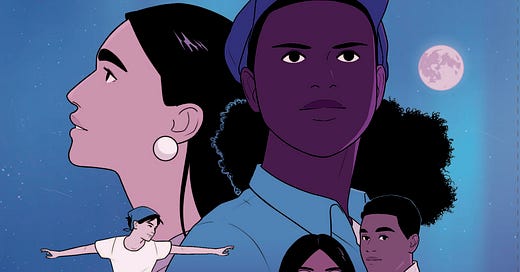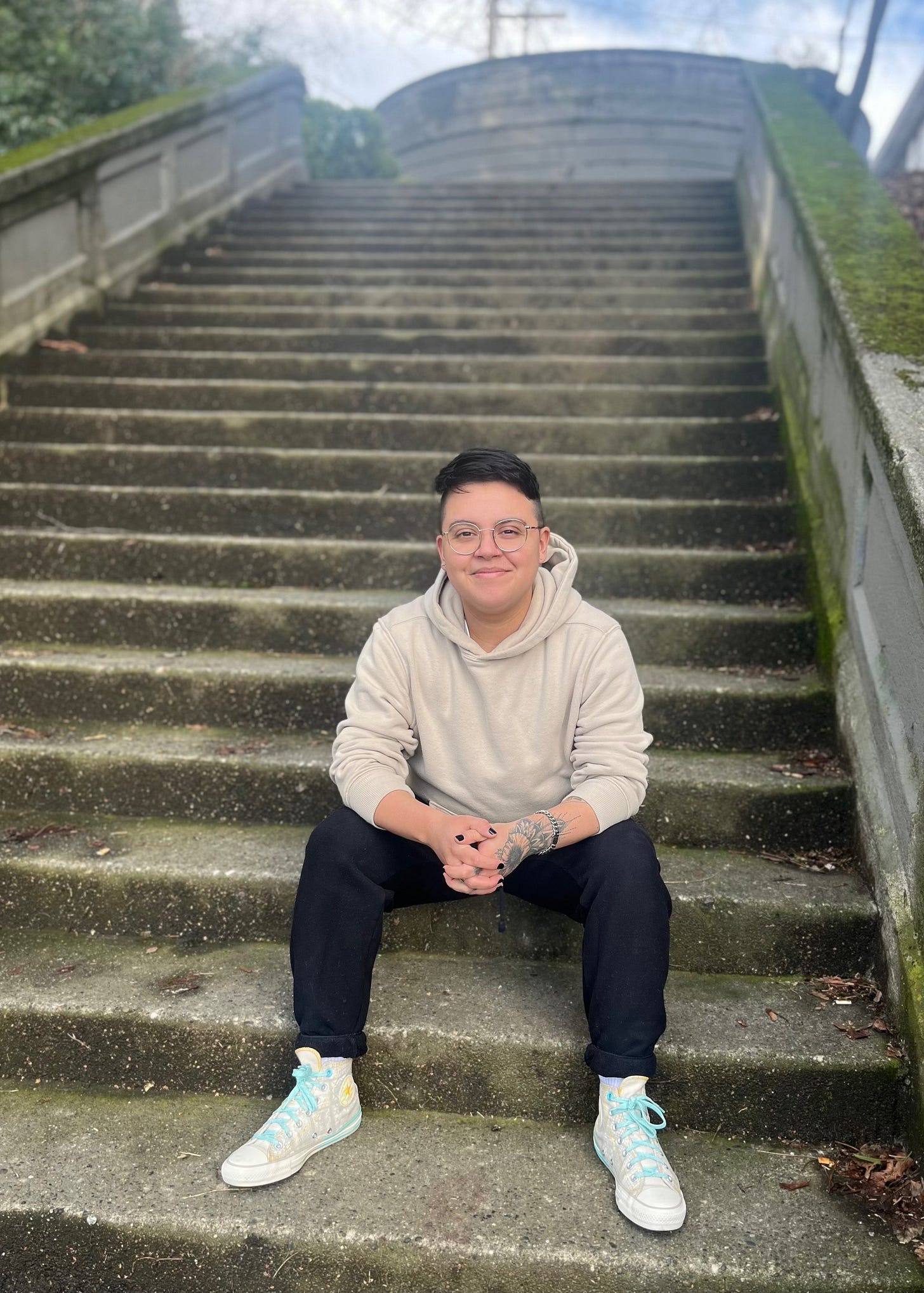Brooms is the Radically Queer and Witchy Comic You've Been Waiting For
Jasmine Walls and Teo DuVall talk their stunning new graphic novel.
Happy Halloween! As the final part of our super-stuffed spooky season, I'm really excited to share a lovely interview with two of my favorite creators about their newest graphic novel.
Set in an alternate 1930s Mississippi, Brooms centers on six BIPOC witches teaming up to compete in illegal broom races in order to earn money to better their lives in a place where the laws are made to keep them down. Brooms focuses on the bonds of friendships, new and old, and the strength it provides.
If that sounds like the kind of comic you've been waiting years for then you're going to fall head over heels in love with the gorgeous graphic novel from the powerhouse creative team of writer Jasmine Walls, artist Teo DuVall, colorist by Bex Glendining, and letterer by Ariana Maher. This beautifully crafted graphic novel had been on my most-anticipated list all year and easily lived up to the hype. So I was incredibly happy to get the chance to send over some questions to Walls and DuVall, who chatted about the long road to making the book, the historical realities that influenced it, and bringing disabled and Deaf representation to the page.
What was the origin story of Brooms? How did this gorgeous graphic novel come to be?
Jasmine: I had to go digging through my old emails, but I first reached out to Teo back in 2016 with the initial idea for Brooms in a moment of bravery at 2am because I already loved his work and really wanted to team up with him on a book about this scrappy crew of young witches. I really wanted to write a story about the folks with magic who don’t get into prestigious magical schools, who have to fight for their right to even use magic, and I wanted them to be the stars of the story. I’m so glad we were able to accomplish exactly that.
Teo: When Jasmine reached out to me all those years ago, I couldn’t reply fast enough with “YES. YES PLEASE.” I’ve had many, many witch-related projects brought my way, but Brooms was the first one that centered on BIPOC, queer young women and a magic system that wasn’t derivative of a white-centric point of view. It truly resonated with me, and I knew that Jasmine would let me bring myself into the story as well. There was no way I could pass up such an incredible story.
Brooms brings a real sense of history and reality to the fantasy genre it lives in as you actually use the witchy story as a way to explore how magic wouldn't be some kind of fix-all and would instead exist within the systems of oppression that we already have. Could you talk a little about building that balance and the world of Brooms?
Jasmine: It was an intentional choice to weave magic into history rather than use it to sort of sweep away societal issues, because we really wanted to explore not just what magic might change about history, but what might stay the same. As a writer, it was a fun challenge to balance the sense of reality with the fantastical, just like there’s a balance between the heavier topics that are touched on in the book and the more silly, lighthearted moments. We did a lot of research for the book while also slapping in broom races and magic spells being slung around.
Teo: It was really important to me to incorporate historical fashion — particularly Southern, working-class fashion. It’s something so rarely seen in 30s period pieces, and I wanted to honor the era to the best of my ability. This involved a lot of research, mostly because the fashions of BIPOC, working class folks in the south were not as readily documented as their white counterparts. My hope was that by having the characters grounded with a touch of historical reality, their struggles, joys and hopes would feel humanized and relatable to our audience.
I adore how much freedom the crew and their new recruits find in using magic and the community that it affords them. Could you tell us more about the vibrant real life communities who inspired them?
Jasmine: Broadly speaking, we based the broom racing crowd on similar underground queer communities, especially queer communities of color that have existed throughout history, with a sprinkle of illegal road racing vibes. Teo did an incredible job designing the background characters as well as the main teams, which was really important to us. We wanted to build a genuinely inclusive space, where people who are normally pushed to the fringes have a place to thrive.
Teo: I really wanted the characters in Brooms to reflect folks who exist (and have always existed) — people with different body types, skin tones, hair types, gender expressions, physical abilities, etc. In queer friend groups and communities, you see such a diverse and beautiful array of people. I wanted that truth to be represented in the book, to the best of my ability.
Teo, I've been a huge fan of your art for years and I love how much your personal style comes through here even when building this expansive and historically informed world. What was your process for building the visual world and language of the book?
Teo: The process was a long one, though it was definitely a labor of love. I really enjoy doing research, so that was a particularly fun aspect of working on Brooms (I believe I have 200+ files just in my fashion reference folder alone).
My personal artwork leans very modern, so it took some work to get myself into the right headspace for a rural, 1930s setting. I believe I was able to thread that needle once I got the main cast designed. Aside from Luella and Billie Mae, each girl went through a few iterations before I landed on their final designs. Initially I skewed too old with their clothing or hairstyle choices, which was the result of relying heavily on vintage photographs and generally just getting in my own head. With Jasmine’s help I was able to take a step back from that mindset and translate my style into designs that seemed appropriate for the era but didn’t necessarily read as 100% historically accurate — and that’s ok! The most important thing to me was making sure that everyone in the book felt alive and of the same time period.
It was absolutely wonderful as a disabled person to see disabled and Deaf characters in this book. Thank you for bringing them to this magical world where they're so often forgotten. I also loved the way that you brought sign language to life in this book, could you talk about translating that to the page?
Jasmine: Having disability representation was really important to us in the drafting stage of the book, with BIllie Mae, Loretta, and Emma, as well as plenty of secondary and background characters. We even specially designed Loretta’s broom to work with her leg brace. Emma’s sign language took some figuring out to translate to a comic format, especially since the goal was to use a period-accurate (if not regionally accurate) sign language for someone who wouldn’t have learned ASL in a school. We referenced ‘Indian Sign Language’ by William Tomkins, which is one of the few illustrated guides for an American Indigenous sign language from the time period.
Teo: Luckily, Tompkins’ book included very clear illustrations that I was able to reference very easily. Jasmine helped with translating and sourcing pages for me to reference, so from there it was a matter of laying out the panel composition to allow visible signing and being sure to incorporate the necessary hand motions.
This book was years in the making. As you explored the world further, did your research, and actually brought the book into being, was there anything that surprised you about the characters and the journey that they ended up going on?
Jasmine: This story became so much bigger, richer, and more layered than I ever imagined when I sent Teo that very first email. It’s one of the things I love about collaborating in comics, the story got better and better with Teo’s input and our incredibly supportive team at Levine Querido. I also love how much researching a story can influence big and small details, from learning more about thriving Chinese communities in the South to food preservation techniques for folks without refrigeration. The characters’ personalities changed too, becoming so much more realistic and relatable than I could have expected at the start. Luella in particular developed this incredible quiet fierceness that was a joy to write.
Teo: I’ve never worked with an author who encouraged true collaboration more than Jasmine, and I think Brooms became stronger for it. Luella’s scene in the kitchen with her dad was one of my favorites to draw, because I got to illustrate someone using a molcajete. For me, it’s those little details that I think speak to the journey of the book as a whole.
I loved the way the entire team including the flatters was credited at the back of the book. Could you talk a little about that choice? As a comic book writer who always fights to have my whole team properly credited, I'm guessing that was something you were involved in!
Jasmine: Thank you, it’s a detail Teo and I were adamant about. It did take a bit of convincing, but I’m happy to say that our publisher agreed to give full credits to the whole creative team. I’m hoping it means we’ll be an example for other creative teams to use as we begin to make it a standard practice.
Teo: I have to give extra kudos to Jasmine on this one. She was the heart of our team from the very beginning and had our backs through mental health struggles, pandemic woes and everything in between. When she told me that she wanted to get the whole team credited I was blown away by just how far she would go to support the people she works with, and I’m so grateful for it.
You can get Brooms from your favorite bookshop now!








This sounds amazing! Definitely gonna read this one!